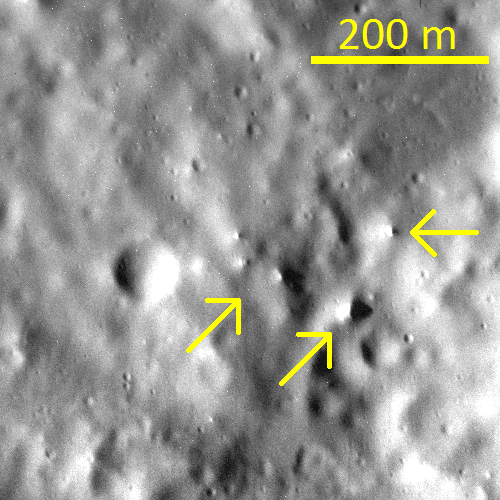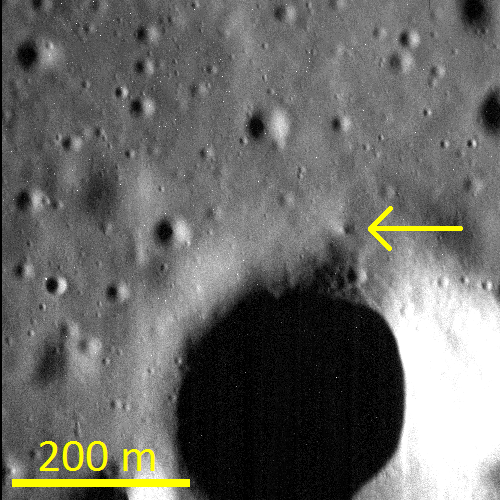Rarity of Boulders on Mercury: Possible Causes
- 1University of California Santa Cruz, Earth and Planetary Sciences, Santa Cruz, CA, United States of America (mkreslav@ucsc.edu)
- 2Moscow State University of Geodesy and Cartography (MIIGAiK), Moscow, Russia
- 3Sternberg Astronomical Institute, Moscow State University, Moscow, Russia
- 4Finnish Geospatial Research Institute (FGI), Masala, Finland
- 5Department of Physics, University of Helsinki, Finland
Introduction
Boulders, meters-size blocks of rock, are seen in great numbers in high-resolution images of the Moon, Mars, and small bodies. Boulders and their geological associations provide information about surface processes on these bodies. Here we report on rarity of boulders on Mercury, and discuss possible implications of this.
Rarity of boulders on Mercury
We studied boulders on Mercury with high-resolution images acquired by MDIS NAC camera onboard MESSENGER. We screened all ~3000 images of the highest resolution (<2.5 m/pix sampling) and acceptable quality, and found discernable boulders only in 14 of them (see examples in Fig. 1,2) [1]. The highest resolution images are small (0.25 Mpix), have a considerable smear, low signal-to-noise ratio, and are separated by large distances; they can be considered as random samples of surface morphology in a region limited by 40 – 70°N and 210 – 320°E, which is occupied mostly by the intercrater plains. The majority of the found boulders are associated with a single large young impact crater (Fig. 1), and a few boulders are associated with small impact craters (Fig. 2). With the available images, it is impossible to distinguish between intact boulders and debris piles of disintegrated or partly disintegrated boulders, therefore such (partly) disintegrated boulders are included in our boulder count.


To compare Mercury with the Moon, we extracted similar random 0.25 Mpix samples from LROC NAC images that have the same sampling, the same solar illumination incidence angle and are situated in highlands. We artificially degraded image quality to mimic MDIS NAC quality. Then we screened these image samples searching for boulders and found them at ~15% of the random sample images. Thus, boulders on Mercury are extremely rare in comparison to the Moon (~ 30x less abundant).
Possible causes
Boulder population on the Moon is dynamic: the characteristic boulder lifetime is ~100 Ma [2], and the observed population represents equilibrium between boulder formation and obliteration. The same obviously occurs on Mercury. Therefore, much sparce boulder population can occur due to a lower production rate, a shorter lifetime, or both.
Production rate. Boulders on the Moon occur in association with (1) fresh impact craters of different sizes and (2) hilltops, upper edges of rilles, and other convex relief forms. Respectively, there are two mechanisms of boulder formation: (1) bedrock fragmentation and excavation by impacts, and (2) progressive exposure of pre-existing blocks and fractured bedrock by removal of regolith layer from convex relief by diffusive creep. On Mercury we observe boulders in the first type of settings (craters) only. The intercrater plains on Mercury are significantly smoother than the lunar highlands [3], therefore suitable hilltops may be less abundant and might not be sampled in our limited image set. Thus, the general smoothness of Mercury in comparison to the Moon [3] may contribute to a lower boulder production rate.
Regolith on Mercury is thought to be thicker than on the Moon [3,4]. The smallest craters are forming in regolith and cannot excavate boulders. Due to the thicker regolith, the onset crater size for boulder formation is larger. Since the crater formation rate on Mercury is on the same order of magnitude, the larger onset crater size means a lower rate of boulder-forming impacts, and therefore, a lower boulder formation rate. However, these two factors seem insufficient to explain the huge difference in boulder occurrence between the Moon and Mercury.
Lifetime. Boulders are destroyed by small meteoritic impacts, ground by micrometeoritic impacts [2], and cracked and disintegrated by thermal stresses [5,6]. The relative role of these processes on the Moon is controversial. Since meteoritic flux is on the same order of magnitude on both bodies, it cannot account for the observed huge difference.
Peak daytime temperature at a flat monolith bedrock surface induces tensile stress equal to E α ΔT/(1-ν), where E is the Young’s modulus (~60 GPa for basalts [7]), ν is Poisson ratio (~0.25), α is linear thermal expansion coefficient (~10-5 K-1), and ΔT is the peak temperature excess above the mean temperature. For Mercury, this stress would regularly exceed 100 MPa. This value gives an order of magnitude estimate for peak tensile stress experienced by a boulder, if it is larger or comparable to the diurnal thermal skin depth for solid rock, which is ~3 m for the long day on Mercury. For smaller boulders the peak stress is lower; detailed modeling has been done in [5]. The boulders we observe are larger than 3 m, therefore, the peak stress is on the order of 100 MPa, much higher than a typical tensile strength of intact basalts (~14 MPa [7]). Therefore, all boulders acquire boulder-scale fractures at their first exposure at the surface. The difference Δα between thermal expansion coefficients of rock-forming mineral grains leads to thermal stress at grain scale [6]. They are scaled as C E Δα ΔT, where C depending on ν and grain geometry is on the order of unity. These stresses would also routinely exceed tensile strength; they would lead to formation of microfractures at grain scale. Thus, thermal stresses cause extensive fracturing of rocks on Mercury, which likely contributes to the short boulder life time.
The micrometeoritic flux on Mercury is significantly higher than on the Moon [8,9]. If micrometeoritic grinding is the dominant boulder obliteration mechanism on the Moon, then the difference in the micrometeoritic flux is likely to be sufficient to account for the entire observed difference in boulder abundance.
References
[1] Zharkova A. et al. (2019) LPSC 50, 1162.
[2] Basilevsky A.T. et al. (2013) PSS 89, 118-126.
[3] Kreslavsky M. et al. (2014) GRL 41, 8245-8251.
[4] Zharkova A. et al. (2015) AGU Fall, P53A-2099.
[5] Molaro J. et al. (2017) Icarus 294, 247-261.
[6] Molaro J. et al. (2015) JGR 120, 255-277.
[7] Schultz R. (1993) JGR 98, 10883-10895.
[8] Cintala M. (1992) JGR 97, 947.
[9] Borin P. et al. (2009) Astron. Astrophys. 503, 259.
How to cite: Kreslavsky, M. A., Zharkova, A., and Gritsevich, M.: Rarity of Boulders on Mercury: Possible Causes, Europlanet Science Congress 2020, online, 21 September–9 Oct 2020, EPSC2020-958, https://doi.org/10.5194/epsc2020-958, 2020

